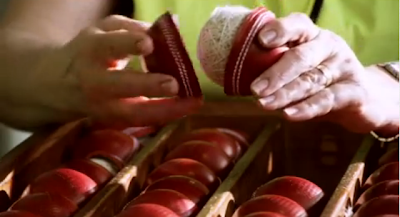In Modern day cricket, test cricket is played with red balls
and other forms of cricket are played with white balls. In earlier days both
test and one day cricket were played with traditional red balls. With day and
night one day matches coming into existence, red balls became a problem under
flood lights and so white balls were brought in to lime light. Cricket balls
are dangerous which even caused death to some players and are hard enough to
cause serious injuries.
Cricket balls are made out of leather, cork and yarn. Cork
is tightly wrapped with yarn and made into a sphere. This sphere gives the
required magnitude and weight to the ball. Leather is cut into circle and is
put into machine and made into hemispheres.
The ends of the hemispheres are given stiches before inserting the cork.
Once the hemispheres are ready, cork is put into the two hemispheres and joined
and stitched together. Even today most of the tasks involved in ball making are
done with hand. After the ball is finished, It is made spherical enough with
the help of machines and polished.
 |
| Hemispheres made out of leather |
 |
| Leather used to make cricket balls |
 |
| Making the cork |
 |
| Cork betweeen two hemispheres |
 |
| Making the ball spherical and polishing |
 |
| Stitching the two hemispheres after joining |
 |
| Finished balls |
Cricket balls need to follow some measurements in order to
make it usable for international cricket. There are ICC regulations for weight
and measurements of a ball. An usual cricket ball should weigh between 155 to
163 grams and circumference should be 224 to 299 millimeters.
Kookubura, SG , Dukes are the leading cricket ball
manufacturers . Based on the country which is hosting which is hosting the
match ball brands are chosen with the approval of the national cricket
board. Matches hosted by India are
played with ball manufactured by SG.
 |
| BCCI approved SG balls |

























I do agree - I work with the coaches at my native cricket ball, and also the laborious ball is often a challenge for the kids. we tend to use soft ball games to urge them wont to touching and catching.
ReplyDeletehas ever been made faux leather or any other synthetic leather cricket ball as compare as real leather ball wich we cam play in matches. i m not talking about that soft ball ? please ans me
ReplyDeletemy id is dhruvjadeja21@gmail.com
Really awesome post!
ReplyDeleteCricket Ball Manufacturers
Such a great Post!! Thanks For Sharing. Are you looking to buy your first Leather Ball? It’s all available at just a click:Leather Balls
ReplyDeleteThanks For Sharing !! Really awesome post !!
ReplyDeleteI know one Cricket Leather Ball Exporter who is manufacturing our Club Balls with proper quality Management and Proper following ICC Rules. I Love NEXUKE Brand Cricket Leather Balls very much.
Such a great Post!! Thanks For Sharing.
ReplyDeleteIt is good you can buy the cricket club balls with good quality. But i know one cricket manufacturer.The quality of the cricket ball is very high as the compare the other Cricket Leather Ball Manufacturer.Those balls gives me 100% satisfaction.
I also played with the many differnt types of the leather cricket ball. But now i prefer to you buy the ball from the NEXUKE laether cricekt ball brand Red Leather Cricket Ball . Because they gives the quality in their cricket ball.The quality of the that ball is fabulous. It gives me more swing .
ReplyDeleteAll cricket balls are made from cork and alum tanned leather.But in the NEXUKE cricket leather ball,they used the world best manufacturing process in the making of
ReplyDeletepink color-leather-ball.Their pink leather cricket ball is very awesome. I love very much NEXUKE brand cricket leather ball.
Really awesome post!
ReplyDeleteAll cricket ball manufacturer and exporter provide the best service.But Nexuke cricket leather ball provide the awesome service. Any other cricket manufacturer and exporter can not compare with its service.
White Leather Cricket Ball Exporter
I utilized the many types of the leather cricket ball but now I am utilizing the Nexuke brand cricket leather ball. The manufacturing and exporting system the this cricket brand is the best in the world.
ReplyDeleteCricket Leather Ball Manufacturer
I have withal having a Cricket Club from last 2 years we are utilizing NEXUKE Brand Leather Balls in 2015 and the Company provide me superior quality White Leather Cricket Ball as my customized requisite. I authentically recommended all buyer and traders to purchase this Nexuke Cricket Leather Balls..
ReplyDeleteNice Post
ReplyDeleteI like your post it is really informatics. We also share with you some information about cricket bats. We offer Leather Cricket Ball or Cricket Batting Gloves.
Usable for international cricket. There are ICC regulations Thanks for sharing useful blog tennis ball
ReplyDelete